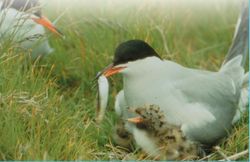Possible causes for breading failure in common terns
Mogelijke oorzaken van slecht broedsucces in de visdiefkolonie bij terneuzen. Stand van zaken en aanbevelingen - 2003
Context of the study
Since 1997 the Dutch Coastal and Marine institute (RIKZ) monitors the breading birds of the Delta area. One of these breading birds is the common tern. In 1994 the colony in Terneuzen was struck by serious signs of illness, while the other colonies in the delta area remained healthy. The number of breading couples decreased strongly, and the breading outcome was terrible: eggs didn't hatch, young birds were diseased and suffered mass casualties. In 1999 the signs of illness vanished and the number of breading couples increased again. However, after 2000, the eggs started to show anomalies (small cracks or bulges), which indicated that the population still hadn't recovered.[1]
Content of the study
This study investigated possible causes (both ecological as chemical) for the problems in the common tern colony of Terneuzen.
Main results of the study
The study eliminated 2 of 3 hypothetic causes: namely infection by viruses or bacteria and suffocation by certain plants. This leaves chemicals as the only potential cause. Three groups of chemicals have been encountered in higher concentrations in the Terneuzen colony than in other colonies: organotin compounds, PBDEs and "unidentified substances". However further research is necessary to determine which of these 3 groups of substances caused the problems of the common tern colony.
You can find more information on this study through this link
As part of the INRAM project, the eggs of the Belgian common tern colony near Zee-Brugge are also being monitored for contaminants. You can find more information on this through this link

